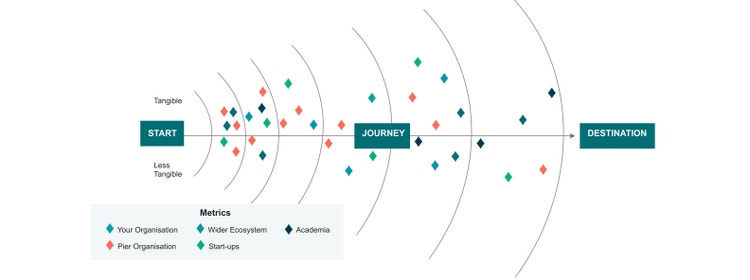

Insights
How to overcome implementation challenges of an open innovation ecosystem
Adrian McGrath, Client Partner and Digital Transformation Lead
With advanced technology and the ease with which we connect and build working relationships with people and companies worldwide, change is accelerating at an incredible speed.

Adrian McGrath, Client Partner and Digital Transformation Lead
Open ecosystems for innovation are the new norm
Bill Joy of Sun Microsystems says, "No matter who you are, most of the smartest people work for someone else.” This is very true, and this realization is transitioning the innovation strategy for most organizations towards an open and collaborative model with multiple partners that span organizational boundaries.
With advanced technology and the ease with which we connect and build working relationships with people and companies worldwide, change is accelerating at an incredible speed. It makes good business sense to form partnerships within an ecosystem of companies to drive innovation and value for end customers. This way, innovation outcomes are achieved faster, with less risk and cost, and the collaborative ideation between participating companies often opens up new revenue channels and business models.
However, collaborating across an ecosystem of partners can be challenging. This article looks at four key strategic and operational challenges that can surface within an innovation ecosystem and the steps to mitigate them.
Strategic Challenges of Open Innovation Ecosystem
With advanced technology and the ease with which we connect and build working relationships with people and companies worldwide, change is accelerating at an incredible speed. It makes good business sense to form partnerships within an ecosystem of companies to drive innovation and value for end customers. This way, innovation outcomes are achieved faster, with less risk and cost, and the collaborative ideation between participating companies often opens up new revenue channels and business models.
However, collaborating across an ecosystem of partners can be challenging. This article looks at four key strategic and operational challenges that can surface within an innovation ecosystem and the steps to mitigate them.
- Shared Vision- As illustrated in figure 1 below, an open innovation team is typically made of multiple partners spanning start-ups, academia, peer organizations and third parties within a wider ecosystem. Each of these partners is likely to apply a different “lens” to the collaboration with their own agenda and goals, offer different levels of commitment and operate at different speeds. It is really important for the success of the collaboration that these differences are recognized and discussed up-front, establishing a shared vision to underpin the Open Innovation Team.
- Alignment of innovation to business strategy- In addition to bringing together partners to form an Open Innovation Team, it is also important to invest significant time with the business to listen to and understand their needs. These include the challenges at the operational edge of the business and working out what innovation streams will drive short and longer-term value. Without this, there is no easy route to disseminate, evaluate and absorb innovation into the business.
- Trust and Openness- Implementing a trusting and open relationship among all partners in the Open Innovation Team is not easy to do in practice, especially with peer organizations that have the potential to be competitors. However, if it is not done, the innovation partnership is unlikely to last very long. Establishing defined roles, expectations, and boundaries up-front for each partner helps to facilitate open communications. Ultimately, it is about people putting the time and effort into building business relationships and trusting each other, irrespective of their organization, that makes the difference.
- “Losing learning muscle”- Innovation projects will evolve and pivot. Many will fail. That comes with the territory of innovating something new and different. However, it is important not to fear failure and attribute blame to individual partners but instead learn from it, evolve and keep going. It is akin to building a “losing learning muscle” that takes failures in its stride. Establishing this philosophy within the collective innovation partnership is one thing; extending it within the business that is funding the innovation requires closer collaboration, trust and commitment.

Figure 1 – illustrative Open Innovation Team configuration aligned with the business
Operational Challenges of Open Innovation Ecosystem
- Governance framework- Commercial partnerships can be challenging once operations begin, especially when the “pot of gold is at the end of a long rainbow,” requiring significant investment from individual partners. It is critical to spend time at the outset of the innovation to firmly establish governance factors such as Roles & Accountability, Resource & Funding input, Legal & IP ownership, and Scope & Timelines.
- When things go wrong- Innovation projects pivot all the time and keep everyone on target when things naturally change or go wrong, it can be very challenging. In addition, sometimes, the people that you’ve spent a lot of time building relationships with across partner companies can have decisions taken out of their hands. It can help build deeper relationships within each partner organization based on the shared vision and collective value established at the outset.
- Building up credibility- Establishing credibility with the business requires investing time to understand their needs and bringing concepts to life via proof-of-value and pilot projects. Successes should be promoted and celebrated.
- Metrics- Open Innovation projects require agreement and reporting on a broad set of actionable metrics that measure success. There won’t be a single set of metrics that is applicable to all partners, as the metrics will vary based on the different lenses applied by each partner. Like the police “follow the money” to investigate crimes, determining what metrics to capture for innovation projects it is about “following the value.” Don’t establish metrics that don’t measure value. However, not all metrics should be outcome or results-based. Some will incrementally build a capacity/capability over time, linked to the journey, not only the destination. It will create a chain of derived metrics across innovation projects, collectively storytelling the success. Less tangible metrics are also really important, linked to culture and strategic initiatives such as attracting the best talent into the organization. It is the talent that will make the difference in driving the organisation forward and creating value. This concept is illustrated in the figure below.

Figure 2 – Metrics for all partners and aligned to the journey, not only the destination
Open Innovation at UST
UST is a key contributing member of the London & Partners Open Innovation Fellowship. Leveraging our seven dedicated Innovation Labs worldwide, we fully embrace and implement open innovation ecosystems, co-creating and innovating with our clients and partners.